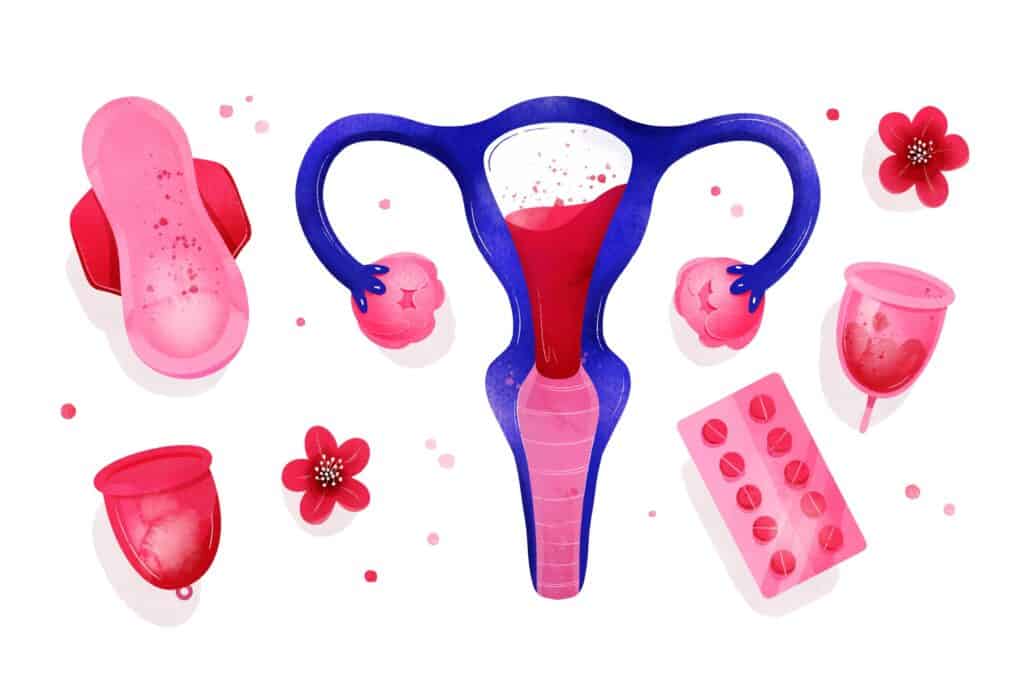Brown Vaginal Discharge: Top 10 Causes & Questions Explained
Help! I have brown stuff coming out of my vag! Is this normal?
We often get questions like this from alarmed readers. Of all the things women experience throughout their reproductive years, brown discharge always seems to be the most concerning.
While brown discharge or spotting can signify that something’s wrong, it’s perfectly normal in most cases.
The first and most important thing is not to panic. The second is to understand better what this vaginal discharge is and what’s causing it. We’ll cover some of the most common questions about brown vaginal discharge so you know what’s going on with your body and whether a visit with the doctor is justified.
What Does Brown Vaginal Discharge or Brown Period Blood Mean?
Below are the ten most common reasons or conditions.
Q1: Why Is My Period Blood Brown?
Why do you see brown discharge in the first place? Dark vaginal discharge occurs when a little bit of old blood mixes in with your normal vaginal discharge. The reason why the blood is brown is because of its age. As blood moves through the body, it ages and begins to dry. Old blood is brown, whereas red or pink blood is fresh.
Q2: Why Is My Vaginal Discharge Brown?
What causes brown spotting? There are seven possibilities, including:
- Ovulation: Sometimes, in the menstrual cycle, when an egg is released during ovulation, a little breakthrough bleeding occurs. This blood mixes in with your normal vaginal discharge, so your discharge might be dark brown. Note that the breakthrough bleeding isn’t harmful in this case and is not a sign of cervical cancer or ectopic pregnancy.
- Endometrial tissue: In some cases, this discharge is just old tissue that did not pass during your last menstrual cycle. This tissue may remain in the uterus for quite a while before it passes, which is why the discharge is brown.
- Perimenopause: Just before menopause, your body’s hormone levels are rapidly changing. At this time, you may see yellow, pink, or even brown discharge.
- Birth control: Hormonal birth control can cause irregular periods and spotting or brown discharge.
- Pregnancy: Implantation can cause your discharge to look brown. It may also signal a problem with the placenta. This can lead to implantation bleeding.
- Miscarriage: Some women will see dark brown blood or discharge during the early stages of a miscarriage.
- Disease: According to the National Cancer Institute, certain conditions can cause your discharge to turn brown, such as bacterial vaginosis, PID (pelvic inflammatory disease), cervical cancer, and certain sexually transmitted infections.
If the discharge is dark pink or brown and carries a foul-smelling odor, there is cause for concern, and you should see your health care provider right away.
In most cases, brown-colored discharge is nothing to worry about, but if you’re pregnant and seeing a lot of fluid, it may be time to see your healthcare provider and make sure that you and your baby are healthy. Trustworthy health providers will process your personal data safely and give you health information promptly.
Q3: Why Is My Period Brown?
Brown blood during the period is perfectly normal. It may be alarming to see dark brown or even black blood, but this is nothing more than old endometrial tissue being passed.
While your body does its best to shed its uterine lining as efficiently as possible, sometimes tissue gets left behind. Brown period blood is simply old blood from old endometrial tissue that took a while for your body to pass.
Q4: Pink or Brown Discharge Before Period – What Does It Mean?
Such mucosa before a period is not as common, but it can happen.
- It could be a sign of your body passing old tissue in an attempt to clean out your uterus. This may be a week or two weeks before your period.
- It also could be a sign of pregnancy.
If you experience brown discharge, take an at-home pregnancy test or see your health care provider.
If you know for sure that you are not pregnant, there’s likely nothing to worry about. The discharge should pass. If it does not, see your doctor and check for infection or an STD. Sometimes visiting wellness professionals is expensive but of crucial importance in such instances.
Q5: Brown Discharge After Period – Is It Normal?

Yes, for the most part. Brown menstrual blood or discharge is prevalent after a period. It’s just the body passing old tissue that may have been left in the uterus for a few days. As mentioned previously, the blood or discharge looks brown because the blood has aged. Old blood is brown.
Of course, brown vaginal fluid can also be a sign of something else, such as:
- Implantation bleeding (learn more here)
- Hormonal fluctuations
- Severe yeast infection
- Diseases such as cervical cancer or bacterial vaginosis
Because of the timing, it’s improbable that the brown-colored discharge you’re seeing is implantation bleeding. If it’s occurring right at the end of your period, your body has yet to ovulate, so implantation (or fertilization) could not have happened yet.
If you see this discharge shortly after you’re expected to be ovulating, then it may very well have been caused by implantation. But you’ll have to wait until your expected next period to take a pregnancy test.
Q6: Why Do I Have Brown Discharge Instead of Period Blood?
If you’re expecting your period but are only seeing brown discharge, it’s perfectly natural to be concerned. Several things could be causing this:
- Ovarian Cysts or PCOS: Women with PCOS or polycystic ovary syndrome may have what’s called anovulation, which occurs when the body fails to release ova for three months or more. Data shows that many women with ovarian cysts have brown-colored discharge instead of their cycle as a result.
- Pregnancy: Implantation can also cause light bleeding, which may manifest as dark or light brown spotting. In this case, the discharge is normal.
- Spotting: Sometimes, this discharge is just a sign that your period will start soon. If your cycle is irregular, you may assume that your period should have started when menstruation is a few days away. In this case, it’s normal to see light spotting or blood-tinged discharge.
If the discharge continues and your period does not start, take a pregnancy test. If the test is negative, see your doctor right away to ensure you don’t have an infection or a sexually transmitted disease. In this case, the health and wellness professionals will collect and securely process your personal data to deliver the best service and help you.
Q7: Is It Normal to Have Brown Discharge on Birth Control?
It can be. Data shows that birth control alters hormone levels in your body. Because hormones are responsible for the onset of menstruation – and ovulation – it’s no surprise that many women experience spotting or brownish-color discharge when they’re on birth control.
Talk to your health care provider about what you’re experiencing. You may need to alter your birth control, or there may be another underlying issue.
Q8: Why Do I Have Brown Discharge After Sex?
It’s perfectly normal to see some discharge after having sex, and sometimes, a little bit of blood mixed in with this fluid.
When you’re aroused, the body produces more fluid to keep the vagina lubricated and to assist in the sperm making its way up to the egg. You might see more discharge around the time of ovulation, and if bleeding occurs when the egg is released, it may appear brown.
You might also have slight bleeding from rough intercourse, which can cause your discharge to turn brown.
Q9: What Causes Brown Gooey Discharge?
Brown mucus discharge can occur for several reasons. It might be a sign of ovulation, or if you’re in the third trimester of your pregnancy, an early sign of labor.
During the third trimester of a pregnancy, many women have brown mucus or discharge. A placenta lying low in the uterus or a placenta that separates from the uterus (partially or entirely) may cause you to pass brown, gooey mucus. Dilation can also cause you to pass the brown cervical mucus.
Some brown, gooey discharge may also be a sign of a hormonal imbalance. This might be caused by your diet, birth control, or even stress.
Gooey mucus might also be a sign of ovulation or an STD.
The bottom line? See your doctor if you’re passing some gooey or stringy brown discharge.
Q10: Is Brown Spotting a Sign of Pregnancy?
Dark brown vaginal discharge or spotting can be a sign of pregnancy. Some bleeding occurs when a fertilized egg implants itself into the uterine wall. However, if vaginal discharge persists, it may be a sign of ectopic pregnancy.
What Brown Discharge Looks Like
Brown discharge is just like normal discharge, but it’s brown. The discharge can be anything from:
- Watery
- Creamy
- Egg-like
This won’t be a stream of brown liquid but rather a mucus that exits the vagina. Brown can be light brown or dark brown, and in rare circumstances, a woman may suffer from black discharge, too.
If a woman’s discharge is black, this might result from old blood left inside the woman from her last period. A woman’s body may fall to expel the blood, and if blood is left in the body, it dries, and the discharge will expel it over time.
Brown Discharge During Pregnancy

So, you are finally confirmed that you got a baby. Wow – congratulations! But lately, you’ve been getting this unusual brown vaginal mucus. Should you call your doctor, or is this just another symptom of pregnancy?
However, discharge is common throughout the menstrual cycle and is typically no cause for concern (provided you have no other symptoms). But we’re going to focus on discharge during your pregnancy, which can sometimes be concerning.
Brown Discharge in the First Trimester
Seeing brown discharge during pregnancy in the first three months can be especially concerning. Most women are naturally worried that this type of discharge, tinged with blood, is a sign of a miscarriage.
In most cases, the good news is that brown discharge is nothing to be concerned about – even in the first trimester.
Many things can cause this type of discharge color early on in a pregnancy.
- Implantation Cycle. When a fertilized egg attaches to the uterine lining, it can cause light spotting. If the blood takes some time to leave the body (which is common), it may appear as a brown discharge because the blood is old.
- Irritation. The cervix is extra sensitive during pregnancy, and slight irritation from sex or an exam can cause spotting. That spotting may mix with your normal discharge to make it appear brown.
Brown discharge is common in the first trimester and is typically no reason to worry. But if the discharge continues or blood flow gets heavier, call your doctor or midwife right away.
Brown Discharge in the Second Trimester
What happens if the discharge appears in the second trimester of your pregnancy?
Spotting is common throughout pregnancy and is typically harmless for both you and the baby.
In the second trimester, brown discharge is typically the result of irritation of the cervix. Routine pregnancy exams and sex can irritate the cervix, which can cause light bleeding. The blood then mixes with your usual discharge to create a brown-colored discharge.
While usually harmless, brown discharge may also be an indication of an infection that requires prompt treatment, such as:
Yeast Infection
https://www.youtube.com/watch?v=N8hTB9Y9utc
Yeast infection is extremely common during pregnancy and can cause changes in discharge. Symptoms include:
- Thick discharge that looks like cottage cheese
- Redness, itching, and burning of the vagina
- Painful urination and intercourse
If you’re experiencing any of the symptoms above, see your doctor right away to find the best treatment option for you.
Sexually Transmitted Infection

Pregnancy does not protect you from contracting an STI (sexually transmitted infection). If you or your partner have been having unprotected sex with different partners, it’s important to get tested and see your doctor right away.
Sexually transmitted infections can cause brown discharge with the addition of the following symptoms:
- Discharge that looks like pus
- Burning during urination
- Green or yellow, foul-smelling discharge
- Inflamed vagina
STI can affect the fetus’s health, so it’s important to seek treatment as soon as possible.
PID
Pelvic inflammatory disease, PID, is a serious infection of the female reproductive organs. You may suffer lifelong damage of the:
- Uterus
- Fallopian tubes
- Ovaries
The main reason for women being infertile is PID. Over one million women in the United States alone suffer from PID every year. And 1 in 10 of these women will become infertile.
Bacteria that enter the vagina are the cause of this disease. An STD, often gonorrhea or chlamydia, will weaken the cervix, causing it to become infected. The cervix protects your reproductive organs by expelling and making it difficult for bacteria to enter the organs.
When compromised, bacteria can pass through the cervix, and this results in PID.
This is a significant concern for women, and you may suffer from:
- Infertility
- Permanent reproductive system damage
- Pain when urinating
- Vomiting
- Dull pain over the lower abdomen
- Green or yellow discharge
Brown discharge is less common, but PID can cause brown discharge, too.
Proper medical treatment is required to stop the infection. A health care provider will deliver relevant experience and support in such cases. An STD causes most PID cases, but childbirth and abortion may cause PID, too.
Brown Discharge in the Third Trimester
Discharge is also common in the third trimester of pregnancy and can be tinged with old blood and make it appear brown.
Like in the first and second trimesters, brown-colored discharge can result from irritation in the cervix. Exams and sex can still cause light spotting even in the third trimester of your pregnancy.
But this type of discharge can also be a sign that you’re about to go into labor.
A few days or weeks before labor, you’ll lose your mucus plug. The mucus plug is a glob of mucus that plugs or seals the cervix to protect the baby during pregnancy.
Around the time you lose your mucus plug, you may experience “the bloody show,” which is a mucus-like discharge that is brown or pink.
Losing the mucus plug means that your cervix is softening in preparation for labor and delivery. The bloody show signifies that the blood vessels in your cervix are starting to rupture as it dilates.
Once you experience the bloody show, you’ll likely go into labor within the next few days.
When to See a Doctor

Brown discharge may cause complications, such as:
- Ectopic pregnancy
- Miscarriage
- Issues with the placenta
- Infection in the uterus or placenta
If you experience brown discharge with any of the following symptoms, see a doctor right away:
- Blood that turns red or gets heavier
- Blood that turns gray in color
- Cramping or tenderness
- Uterine contractions
- Back pain
Should You Be Concerned about Brown Discharge?
It would be best if you did not ignore any sudden or unusual changes to your cycle. While brown discharge is usually no cause for concern, you should see your doctor if you’re concerned – especially if you’re experiencing other symptoms as well.

